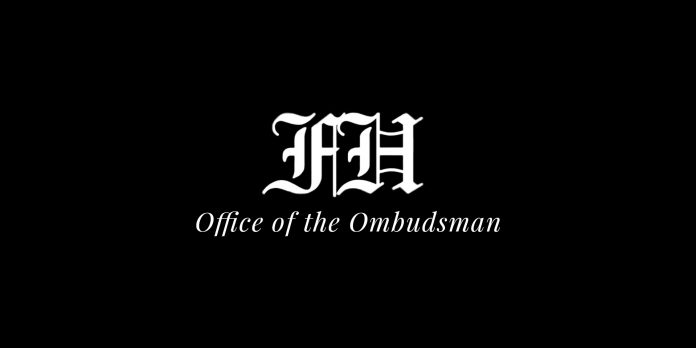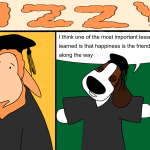The news industry used to be described in terms of column inches and circulation numbers. Nowadays it’s described in terms of word counts and page clicks. The Flat Hat, for example, prints only biweekly (despite saying “The Weekly Student Newspaper of the College of William and Mary) but updates the website frequently.
Printing the physical paper creates a deadline. The print copy must be submitted at a certain time in order for the printing company to guarantee delivery the next day. This is not to say that the physical paper alone is responsible for deadlines. Indeed, they would exist in the absence of the paper with deadlines from editors or considerations of timeliness in breaking news. Without deadlines the news would not be written. Either way, the problems remain.
Deadlines are a time constraint. If you don’t have your story done by that time, it doesn’t get printed. You don’t get your name in a byline. However, at the same time, the paper has to be filled. Blank pages don’t look good to readers. Plus, you as the responsible student journalist did promise to write that article about the new controversy over who-knows-what that happened last week.
There exists, then, a dangerous trade off between getting it right and getting it out.
Deadlines create conflicting responsibilities. On one hand, journalists have a responsibility to the reader to be good journalists. Get the story right. It is vital that they are reporting unbiased, verified truths. On the other hand, journalists have a responsibility to be read. Get the story out. Those truths must be told. There exists, then, a dangerous trade off between getting it right and getting it out. News that needs to get out must be handled with restraint so that journalists don’t offend getting the story right.
Due diligence is a legal term meaning that you’ve done sufficient work to ensure that whatever you’re doing won’t cause harm. It’s usually applied to transactions and business dealings. If I buy an ox from Joe, then I do my research and know that Joe raises healthy oxen. Journalism is a similar transaction. For readership and (sometimes) profit, a media company doles out information. A good media company doles out unbiased and well-verified information.
I like to think of the Flat Hat as being essential to its readers, a good media organization. The news we report contains information and perspectives that may otherwise be lost to the reader. Without the Flat Hat, the goings-on at the College would be relegated to the Z section of the Williamsburg-Yorktown Daily (unless something bad happens and then the College gets front page coverage). This is that first responsibility that journalists have. We have to report what needs to be reported and we have to do it well.
Recently, the paper has covered important issues such as the renaming of buildings on campus, the status of non-tenure eligible faculty, a new student assembly and the College’s Board of Visitors meetings. These are essential news stories to our readers. Without them, members of the community may be left unaware of developments that shape that very community.
That is what I like to think of when I read the Flat Hat. In reality, however, it seems that the responsibility we have to our readers has been dropped in favor of the dueling responsibility to be read. Or should I say clicked on and skimmed over.
Recently, I wrote about the importance of labelling opinions articles as just that: opinions and nothing else. Now it seems I am writing about news articles needing to contain just that: news. I read every article that is published on the Flat Hat website. After all, it is my job to ensure that our standards are being met. And as of this writing I feel that those standards are being shunned in favor of editorializing, single-sourcing and laziness.
The most concerning trend that I’m seeing is in what I call indirect editorializing. This is when a story is presented with only one side being interviewed or consulted, if it has spurious ties to other topics, or if an interviewee’s quote is left with no response. It is the lack of information, what’s not said, that speaks for the reporter. The process of writing a news article should start with the reporter knowing nothing except who to ask about what. Implicit assumptions of logic or information perform a disservice to the truth. Journalists interview experts but they don’t assume they themselves are experts. Source your information. If someone makes a claim, check it.
Do better. Report better. Write better. Edit better. Be better journalists.
This article is not to call out individual authors. It is not a public shaming. This should be read as a call to action. Do better. Report better. Write better. Edit better. Be better journalists. A reader can never be subject to a journalists’ opinion when reading an article labeled “news.” Similarly, the reader should not be subject to a source’s unchecked or unverified statement. If you talk to one side you must talk to the other.
In an increasingly confusing media landscape where words like “insight” and “analysis” are published in front of news articles, The Flat Hat can be better. These are jargon-y terms that perform a disservice to readers. They are confusing, obfuscating and noncommittal. It is not how we should amend this problem. If you write the news, write the news.
This problem with our news coverage, that it has become decreasingly objective, was brought to my attention via a complaint filed more than a month ago. In performing my due diligence, I looked into the complaint. It alleged that an article did not give adequate space to both sides of the story. I could see their point. So I asked the author and editors involved why they hadn’t used more sources. The response I got was “we ran out of time” or “no one would get back to us.”
At first glance these were understandable. They really did try to write the story as it should have been written, reaching out for quotes and information. It was well written and engaging for readers. Plus, it was an important story at the time, one that affected many members of the community. It needed to be read. So in one of my first acts as standards and practices editor I officially closed the complaint, deciding that the semantic content of the story was worthy of publication regardless of the latent content contained therein.
Eschew the ease of editorializing. Do the hard thing and write good news. Deadlines don’t determine due diligence, good standards and ethics do.
In this sense I was wrong. If a story isn’t ready for publication, you don’t publish it. No matter what you think needs to be heard. It has long been the standing practice of this paper to include no fewer than three independent sources in news stories. This cannot change just because we all use email to write news stories now. There are no excuses for not doing your job when your job is to relay the facts.
Journalists have a responsibility to their reader far ahead of their responsibilities to be read. A story is not worth reading if it’s not done properly. An editorialized story wades into the brackish water between news and opinion. This is the type of story that gets referenced in libel cases. This is the type of story that people point to when they say a publication has a bias or an axe to grind. Eschew the ease of editorializing. Do the hard thing and write good news. Deadlines don’t determine due diligence, good standards and ethics do.




































Really appreciate your transparency on your work and places to improve! Keep up the good work